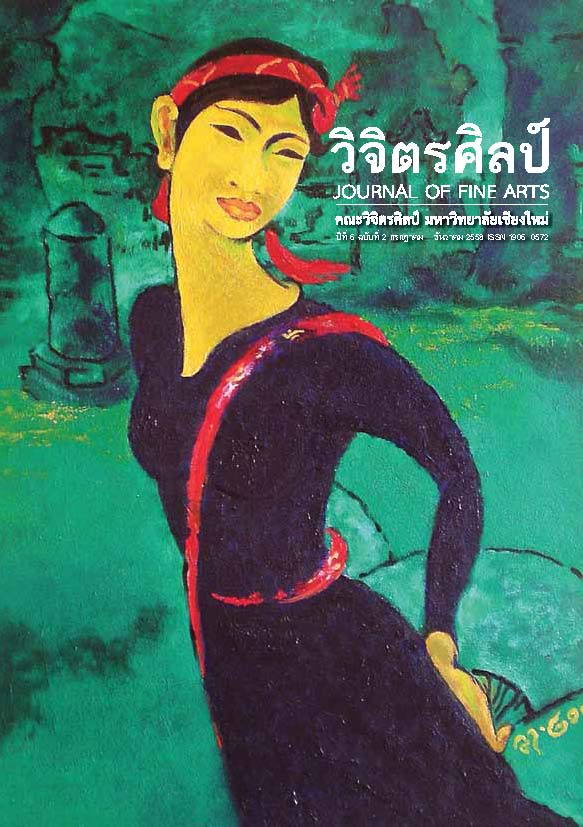การสร้างพื้นที่ศักดิ์สิทธิ์ : จิตรกรรมฝาผนังแบบไทยและแบบพม่าในศตวรรษที่ 17-19
Main Article Content
Abstract
ภาพจิตรกรรมฝาผนังในประเทศไทยมักพบในพระอุโบสถ และพระวิหาร ฝาผนังด้านหลังพระประธานในพระอุโบสถมักแสดงภาพจิตรกรรมเกี่ยวกับไตรภูมิซึ่งก็คือสามพิภพหรือสถาน 31 แห่ง ส่วนฝาผนังด้านทางเข้าแสดงภาพมารผจญพระโคตมะ โดยมีพระแม่ธรณีบีบมวยผมเพื่อหลั่งน้ำพัดท่ามมารไปจากพระพุทธเจ้าส่วนผนังด้านข้างมักแสดงภาพเทวดา และ/หรือ ภาพพุทธประวัติ และเรื่องราวของพระพุทธเจ้าในชาติภพก่อนที่จะเสวยชาติเป็นพระพุทธเจ้า
ในประเทศเมียนมาร์ (พม่า) ภาพจิตรกรรมฝาผนัง ซึ่งมักพบในวัดมากกว่าในวิหาร มักแสดงเรื่องราวของพระพุทธเจ้าองค์อื่นๆ 28 องค์ก่อนพระโคตมะภรพพุทธประวัติ และภาพเรื่องราวของมหานิบาตทศชาติชาดก (10 ชาติสุดท้ายจาก 547 ชาติภพก่อนที่พระพุทธเจ้าจะเสวยชาติเป็นพระพุทธเจ้า) และภาพของนรกภูมิ ภาพผู้คนกราบนมัสการพระพุทธเจ้า ภาพเครื่องรางศักดิ์สิทธิ์ปกป้องจากภยันตราย ภาพที่อ้างถึงรสายนเวท และภาพที่เกี่ยวข้องกับพระพุทธเจ้าองค์ถัดไปหรือพระศรีอาริยเมตไตรย พื้นที่ผนังส่วนใหญ่ของวัดต่างๆ ในประเทศพม่ามักแสดงภาพบรรยายต่างๆ แต่มักเป็นแถบเวียนรอบผนังวัด เวียนจากด้านล่างขึ้นด้านบน ด้วยการแสดงเป็นลำดับขั้นที่เวียนขึ้นนี้ ภาพจึงมักบรรยายแสดงถึงพระพุทธเจ้าตอนที่ยังมีอารมณ์ความรู้สึกไปถึงตอนที่ทรงตรัสรู้ ภาพของพระพุทธเจ้า 28 องค์ในอดีตจะแสดงที่ด้านบนของผนัง ส่วนชาติแรกของทศชาติจะแสดงใกล้พื้นที่สุด ภาพการสักการะพระพุทธเจ้า ภาพนรกภูมิ ภาพแสดงรสายนเวท และภาพวัตถุมงคลมักอยู่ในส่วนเชื่อมต่อด้านข้าง มีไม่กี่กรณีที่มีข้อยกเว้นไม่เป็นไปตามที่กล่าวมา
ในบทความฉบับนี้ ผู้ศึกษาใคร่จะศึกษาว่าพื้นที่ (วัดหรือพระวิหาร) ที่มีจิตรกรรมฝาผนัง จะสร้างอิทธิพลอย่างไรต่อจินตภาพ และผู้ศึกษาได้โต้แย้งว่าการใช้งานพื้นที่ศักดิ์สิทธิ์แต่ละแห่งจะส่งผลต่อลักษณะการจัดวางภาพจิตรกรรมฝาผนังระดับชั้นที่แตกต่างกันทางสังคมของผู้ที่จัดทำภาพจิตรกรรมฝาผนังก็ส่งผลให้เกิดความแตกต่างระหว่างจิตรกรรมฝาผนังที่พบในทั้งสองประเทศ แม้ว่าโครงสร้างการบรรยายเรื่องราวด้วยภาพจะแตกต่างกัน ความหมายที่สื่อด้วยภาพกลับเหมือนกันมาก โดยเป็นการสะท้อนความเชื่อทางศาสนาที่ทั้งชาวไทยและชาวเมียนมาร์ (พม่า) มีเหมือนกัน
Creating Sacred Space: Thai and Burmese Wall Paintings of the Seventeenth to Nineteenth Centuries
Both Thailand and Burma espouse the Theravada Buddhist faith, which unsurprisingly has resulted in similarities in the content of eighteenth and nineteenth-century mural paintings found in temples, assembly halls, and ordination halls. The organization of the murals, however, is radically different in the two countries.
Thai wall paintings are primarily located in ordination and assembly halls. Behind the main Buddha image can be seen the Traiphum, the Three Worlds or the thirty-one states of existence, while on the entrance wall is a representation of Mara’s assault on Gotama, the Earth Goddess’ watery evidence of the latter’s worthiness, and Gotama’s victory. There are celestial beings and/or scenes from the life of Gotama Buddha and his previous lives, particularly the Thosachat (Mahanipata), in rows or panels on the lateral walls.
In Burma, the wall paintings, which are mostly found in temples rather than halls, are largely composed of representations of the twenty-eight previous Buddhas, the life of Gotama Buddha, and the Mahanipata (the final ten stories of the 547 Jataka tales), as well as hell scenes, images of people paying homage to the Buddha, magical protective devices, references to alchemy, and associations with the future Buddha, Maitreya. The majority of the wall space in Burmese temples is devoted to the canonical narratives, however, and these images are painted in strips which wend their way around the temple walls, climbing higher with each circumambulation. Arranged in a hierarchical fashion the narratives reflect the progress from sentient being to enlightened one. The twenty-eight previous Buddhas are found at the top of the walls, while the first of the Mahanipata stories is usually closest to the floor. Scenes of homage, hell, alchemical myths, and magic symbols are, other than a few exceptions, located in peripheral areas.
In this paper I seek to explore how the space (temple or hall) in which the paintings are located has influenced the organization of the imagery, and I argue that the usage to which the sacred space is put has further determined the nature of the organization. The different social levels of the donors further contributed to the differences seen in the murals of the two regions. Despite seemingly radical differences in narrative structure, the meanings conveyed are very similar, in keeping with the shared religious beliefs of the Thai and Burmese cultures.


